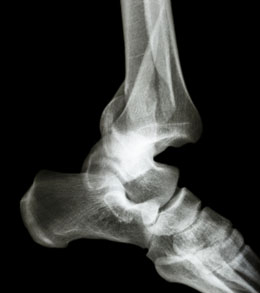This article is aimed at providing information about fibula fracture, complications involved, the surgery, and recovery after the surgery.

A person may need to undergo surgery for a fractured fibula, if any of the bones of the lower leg, such as fibula or tibia, or both, get fractured or broken due to injury. The injury can be caused due to an accident or sports activity or even due to continuous stress on the lower leg. The lower leg contains 2 bones which run from the knee, all the way to the ankle. Out of these 2 bones, inner and larger or thicker bone is called tibia. It is also referred to, as shin bone, whereas, the outer or lateral and smaller bone is termed as fibula.
Human ankle is a weight-sustaining joint made up of 3 bones, such as, distal fibula, distal tibia, and talus. Talus is defined as an ankle bone which joins with tibia and fibula to make ankle joint. Fibula and tibia join together to form a bony protuberance called malleolus. A partial or complete damage to fibula is called a fracture. In wake of an injury causing sudden bend to the foot, the ankle may get twisted outward, which is called eversion injury or twisted inwards, which is called inversion injury. In such a situation, the stress on the ankle gets transferred to fibula and tibia, thus causing a bone fracture. Older people, who are affected by osteoporosis are at a greater risk of causing an injury. This injury or damage needs to be treated by an operation.
Signs
Symptoms are often observed to be inflammation and softness in the lower part of the leg. Person experiences pain and discomfort while walking or on applying stress on the lower leg, due to the swollen ankles.
Diagnosis and Tests Before Surgery
First, the doctor looks for any associated injury of the leg, swelling, tenderness, and conducts a physical examination by pressing the injured area. If there is a fracture in the bone, just a gentle pressing will cause discomfort. X-ray test of the ankle is advised when the doctor suspects of a fracture. X-ray detects the presence of the fracture and also identifies if it is a stable or unstable one. In case of severe ankle fractures, MRI or magnetic resonance imaging test is done to find out about the injuries to ankle ligaments.
Surgical Procedure for Distal Fibula Fracture
It is also termed as lateral malleolus fracture. In case of unstable fractures, surgery is recommended. To perform the surgery, following steps are followed:
- A cut is given on the outside, from one end to the other, followed by soft tissue dissection.
- The next step is to clean the injury or wound, i.e. blood clot removal and the bones are aligned as per the original position.
- Now, the bone is made to hold the original position by inserting a metal plate with screws which presses the fibula to its anatomic position.
Surgery for Tibia Fibula Fracture
In case of tibia fibula fracture, which deals with the inside of ankle bone, following steps are followed:
- Vertical incision is created on the inner part of ankle to treat the injury caused to the tibia.
- The fractured area is then cleaned up to remove blood clot, or hematoma, followed by the original positioning of the fractured bone.
- The position is then hold on to, by tightening a couple of screws with inserted metal rod.
Usually, it takes about 2 months for the fractured fibula injury to heal. The affected person should wear postoperative shoes also called cast boot and has to take care to avoid any weight bearing on the hill. After this period, the affected person can practice bearing a little weight, with protective boots on, for about a month. After this time span, a person can start using normal shoes and continue with the process of restoring the normal condition.
On spotting any kind of pain and discomfort, or in case of injury to the lower leg, immediately consult the doctor to avoid further complications.
Disclaimer:
This Buzzle article is for informative purposes only, and should not be used as a replacement for expert medical advice.


 A person may need to undergo surgery for a fractured fibula, if any of the bones of the lower leg, such as fibula or tibia, or both, get fractured or broken due to injury. The injury can be caused due to an accident or sports activity or even due to continuous stress on the lower leg. The lower leg contains 2 bones which run from the knee, all the way to the ankle. Out of these 2 bones, inner and larger or thicker bone is called tibia. It is also referred to, as shin bone, whereas, the outer or lateral and smaller bone is termed as fibula.
A person may need to undergo surgery for a fractured fibula, if any of the bones of the lower leg, such as fibula or tibia, or both, get fractured or broken due to injury. The injury can be caused due to an accident or sports activity or even due to continuous stress on the lower leg. The lower leg contains 2 bones which run from the knee, all the way to the ankle. Out of these 2 bones, inner and larger or thicker bone is called tibia. It is also referred to, as shin bone, whereas, the outer or lateral and smaller bone is termed as fibula.